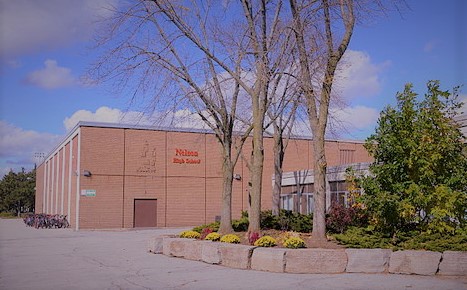Essay by Jackson Carter, published here courtesy of the Halton Black History Awareness Society
This week, Local-news.ca presents the second winning essay from the Halton Black History Awareness Society essay contest for Halton secondary students, “Local Lens: The Black Experience in Halton.” This week, we’ve got first place co-winner and Burlington Central High School student Jackson Carter’s essay. Congratulations, Jackson!
Forgotten Influence: Analyzing the Economic and Social Impacts of the Underground Railroad on the Town of Oakville
Introduction
The Underground Railroad which occurred in both the 18th and 19th century was an organized method of slave resistance which resulted in an increase of fugitive slaves into the “friendlier” northern states and even further north in the British Colonies, now modern-day Canada. The success of the Underground Railroad led to an influx of newly freed slaves into Upper Canada. Compared to the United States, fugitive slaves were given more rights as individuals such as the right to vote and own property however their rights were often impeded by rampant discrimination.1 In addition, freed slaves who fled to the British Colonies faced no threat of extradition which was threatened under the Fugitive Slave Acts of both 1793 and 1850.2 Oakville and other townships in Southern Ontario experienced a vast increase in fugitive slaves escaping through the Underground Railroad following the passing of the Fugitive Slave Act of 1850. The period of 1850 through 1865 represented the largest period of immigration for freed and fugitive slaves into Canada, many of which settled in the village of Oakville and surrounding areas.3 These newly settled immigrants imported and established cultural communities in Oakville and helped the town grow economically through various economic activities and becoming employed in desired occupations such as farmers, dockside workers and housemaids.4 The influence of the Underground Railroad can be seen today in the culture and success of Oakville as a municipality. This essay aims to analyze and explore the influence of the Underground Railroad on the economic and social development of the Town of Oakville.
Economic development
William Chisholm was a moderately successful farmer and postmaster of the nearby Nelson Township. Mr. Chisholm became more involved with the aspects of the naval trade; he was a great supporter of the Burlington Bay Canal and would go on to become “a director in the nearby Desjardins Canal.”5 Hoping to expand into the expanding business of naval trade and ship building, in 1827 Mr. Chisholm acquired 960 acres of land from the local Mississauga Ojibwa First Nation along the Sixteen Mile Creek.5 The geographical location of Oakville made it an extremely valuable port for trade. William Chisholm understood this when he completed work on Oakville’s harbour in 1828 which received boat traffic from Toronto, Hamilton, and foreign markets.6 Over the next decades, the harbour would grow producing more ships and increasing the importance of Oakville in the Upper Canadian economy. This harbour was utilized by “conductors” in the Underground Railroad to transport fugitive and freed slaves to Upper Canada. “Ship captains assisted many escaped slaves by hiding them in grain vessels and sailing across the Great Lakes into the Oakville harbour.”7 Oakville was not only the economic hub of the town, but it was also the gateway to freedom for many escaped slaves away from the oppressive laws of the United States.
When compared to other “stations” in the Underground Railroad, Oakville was relatively unheard of. One of the most well known “stations” was in St. Catharines, Ontario. It had gained prominence due to the efforts of Harriett Tubman, an abolitionist who helped smuggle over 300 fugitive slaves to Upper Canada through the Underground Railroad.8 However, fugitive slaves still managed to find their way to Oakville and build a strong community hoping to start building a better life. When analyzing the economic influence of the Underground Railroad, it is important to acknowledge individuals who worked towards building economic opportunities for newly settled individuals.
One of these prominent individuals was James Wesley Hill who played an important role is economic development of Oakville. Mr. Hill, who was born in Maryland, came to Oakville through the Underground Railroad and started a strawberry farm which made him a modest living.3 However, Mr. Hill also continued to assist with the Underground Railroad. In the coming years, he would aid in the escape of over 700 fugitive slaves from the United States.9 However, Mr. Hill would also have a profound impact on the Oakville economy. He actively invited newly arrived people to work on his farm. He amassed such a large workforce that he turned Oakville into the strawberry capital of Ontario for a period. Many other important figures contributed to the economic development of Oakville from a forested area to a busy bustling town. This economic development is well documented by Genelle Levy in an article for TVO titled “Ontarians should know more about the Black history of Oakville.”10 In the article, the author explores some notable inventions and accomplishments of local Black entrepreneurs, which were either forgotten about or poorly documented in history books. John Cosley, who worked as a barber and gunsmith, was working towards the improvement of firearms and ammunitions when he invented the breech-loading rifle. Mr. Cosley was also well known for his contributions in the local newspaper.10
Another important figure with immense economic contributions to Oakville is Samuel Adams. Mr. Adams escaped to Oakville from Baltimore with $800 of gold in his pockets.10 In addition to settling as a blacksmith in the Bronte area,11 Mr. Adams “invented a device, the stonehooker, that lifted smooth flat stones from the bottom of Lake Ontario, which were then used to construct houses.”10 Mr. Adams through his invention made it easier for Oakville to build homes for new inhabitants and created the conditions in which Oakville could facilitate an increase in population. The economic expansion of Oakville into the thriving township seen today would not be possible without the contributions of Black entrepreneurs such as Mr. Hill and Mr. Adams. They paved the way and encouraged economic growth and prosperity in Oakville and built a strong legacy as important figures in the history of Oakville.
Social factors
The Underground Railroad introduced new people to the relatively small town of Oakville and with it brought a new sense of culture and community to the town that had not been seen before. In the late 19th century, Oakville had gained things that signaled a strong sense of community. Oakville had a community newspaper, they had a church, which represented much more then just a place of worship, and it had a sense of closeness among neighbors. In 1891, the Turner Chapel was built, which became the heart of the Oakville Black community and represented an important steppingstone in the cementing of the Black community in the Town of Oakville. Rosemary Sadlier, who was the former President of the Ontario Black History Society, recently remarked in reference to the importance of the Turner Chapel and the impact on the community: “At one point, the church was everything,” and “It was the gymnasium, the social hub, the place to go for dinner, recreation — everything.”10
The church was also reflective of the struggle of African Americans and Black Canadians faced in the United States and even discrimination face in Upper Canada. The branch of religion worshipped at the Turner Chapel was African Methodist Episcopal Church and as described by journalist and historian Genelle Levy, was an “extension of the Protestant denomination established by African-Americans largely in response to segregation and discrimination from white churches.”10 Within Oakville, the church was an unofficial community hub. The church was a place where celebrations, music, and other events would be shared with the community at large.
The Black community in Oakville was also able express their culture and community through the local newspaper written by John Cosley titled The Bee.12 It was published in the 1860s and was largely done independently by hand according to Lance Naismith who briefly wrote about the history of The Bee in the June 2010 iteration of the Oakville Historical Society Newsletter.12 It is unclear why the production of the newspaper ceased but historians believe it was due to criticism of local elites. Despite the substance or the length of publishing, The Bee was an important reflection of the Black community on the Town of Oakville. It was publishing voices from the Black community about issues and problems within the town that was not always friendly with the Black community. Black citizens of Oakville still faced violence from local white militias who terrorized their neighborhoods. Despite being emancipated and having equal rights, there was still a battle to exercise those rights and be protected from discrimination-based violence. The social development of Oakville as we see it today would not be as successful without the efforts of the Black community. Many of these historical locations still stand to this day and are a reminder of the important impact of the black community and the Underground Railroad on the development of modern-day Oakville.
Conclusion
When analyzing the importance of the Underground Railroad on the development of Oakville throughout the 19th century it is important to reflect upon what Oakville would look like without the Black community. Would it be such a vibrant or prosperous town without the economic and social development undertaken by the Black community on the town. Would William Chisholm’s gamble to build the port at the mouth of the Sixteen Mile Creek be as successful without the surrounding economic development spurred by fugitive slaves fleeing persecution? In looking at how Oakville exists today it is impossible not to see the influence of the Black community on the success of the town. Many of the homes built still stand to this day, Turner Chapel is still standing, and local organizations are still around to teach about the impact of the Black community on modern-day Oakville. In conclusion, the impact of the Underground Railroad on shaping and developing Oakville throughout the 19th century is profound in terms of the contribution to growing the population and building economic prosperity, which is still present today 150+ years later.
Sources:
1Natasha Henry. Black Voting Rights in Canada. The Canadian Encyclopedia. Url: https://www.thecanadianencyclopedia.ca/en/article/black-voting-rights (accessed May 5, 2022).
2Fugitive Slave Acts, Definition & History. Britannica. Url: https://www.britannica.com/event/Fugitive-Slave-Acts (accessed May 5, 2022).
3Natasha Henry. Underground Railroad. The Canadian Encyclopedia. Url: https://www.thecanadianencyclopedia.ca/en/article/underground-railroad (accessed May 19, 2022).
4Town of Oakville. The Underground Railroad. Url: https://www.oakville.ca/culturerec/village-essay5.html (accessed May 18, 2022).
5Biography, CHISHOLM, WILLIAM, Volume VII (1836-1850). Dictionary of Canadian Biography. Url: http://www.biographi.ca/en/bio/chisholm_william_7E.html (accessed May 21, 2022).
6 Town of Oakville. Oakville Museum History. Url: https://www.oakville.ca/museum/history.html (accessed May 18, 2022).
7The Toronto Star. February 4, 2021. Time to Recognize Oakville’s Place in Black History. Url: https://www.thestar.com/local-oakville/opinion/columnists/2021/02/04/time-to-recognize-oakville-s-place-in-black-history.html.
8TVO.org. Why Harriet Tubman Made St. Catharines Her Home. Url: https://www.tvo.org/article/why-harriet-tubman-made-st-catharines-her-home (accessed May 20, 2022).
9James W. Hill Public School. Who Was James W. Hill. Url: https://jwh.hdsb.ca/who-was-james-w-hill (accessed May 17, 2022).
10Genelle Levy, “Ontarians Should Know More about the Black History of Oakville | TVO.Org,” TVO, accessed May 18, 2022, https://www.tvo.org/article/ontarians-should-know-more-about-the-black-history-of-oakville.
11Karisa Simon. September 25, 2021. Ambassador Takeover: Exploring 6 Black History Landmarks in Oakville. Visit Oakville. Url: https://visitoakville.com/2021/09/ambassador-takeover-exploring-6-black-history-landmarks-in-oakville/.
12Lance Naismith. 2010. Tidbits from the Past. Oakville Historical Society Newsletter 44, no. 2 (June 2010).



